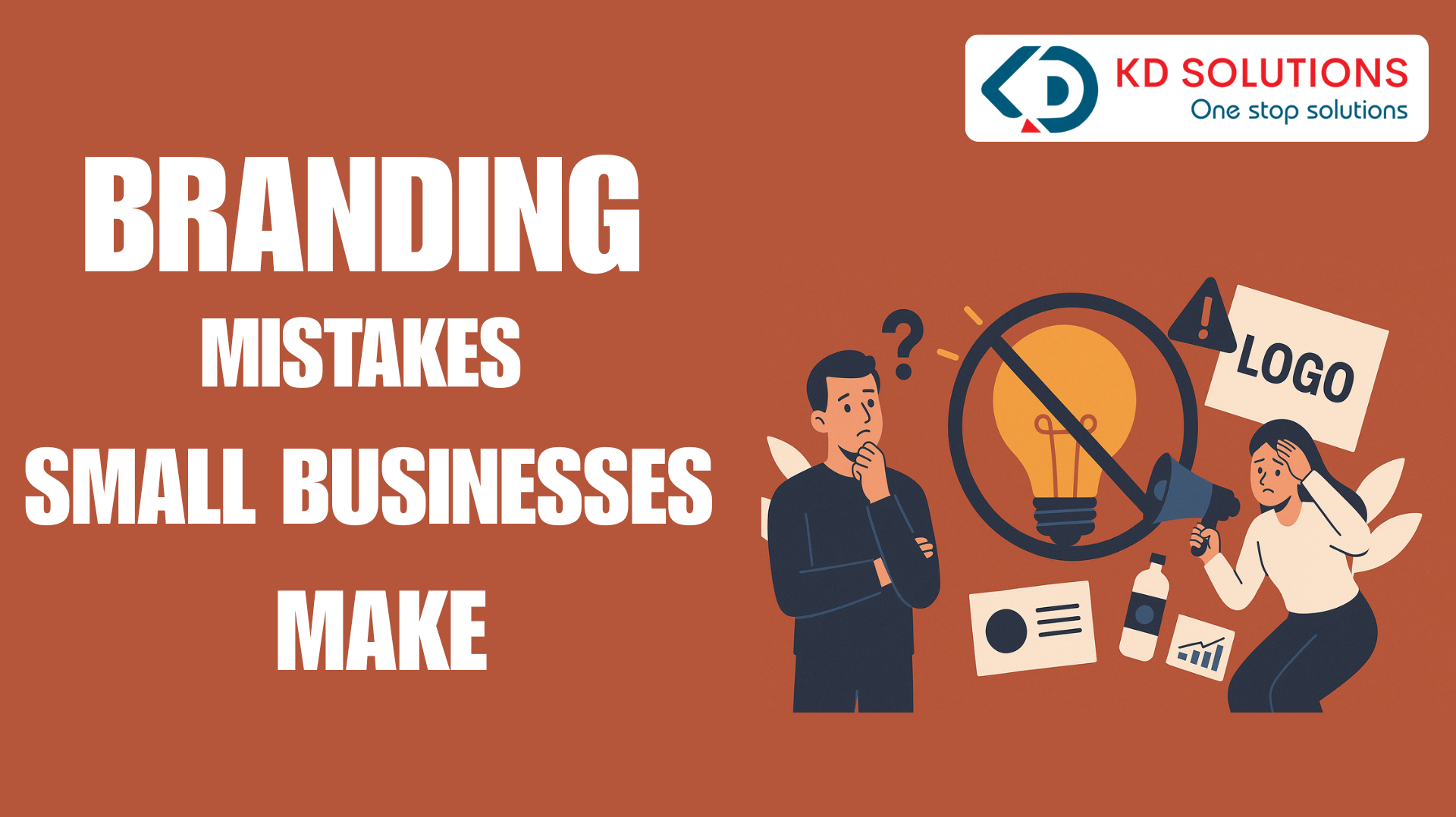Branding is the heartbeat of any business—big or small. It defines who you are, what you stand for, and how your audience perceives you. For small businesses especially, building a strong brand can mean the difference between success and stagnation. Yet, many entrepreneurs fall into branding traps that limit their growth and weaken their market position. Let’s explore the top branding mistakes small businesses make and how to smartly avoid them.
Lack of a Clear Brand Identity
Many small businesses jump into the market without first defining who they are. A brand identity is not just a logo or a color scheme—it’s the personality of your business. When there’s no consistency in voice, messaging, or visuals, customers get confused. A strong brand identity includes your mission, values, visual elements, tone of voice, and overall messaging.
To avoid this, small businesses must invest time in defining their brand identity early on. This includes creating brand guidelines that cover colors, fonts, logos, taglines, and the overall aesthetic that will be used across all platforms. Having a unified identity helps customers easily recognize and trust your business.
Inconsistency Across Platforms
Your website says one thing, your social media another, and your packaging tells a completely different story. This inconsistency is a major branding mistake. Customers crave familiarity. If your branding isn’t uniform across platforms, it diminishes trust and causes confusion.
Avoid this by ensuring that your brand voice, colors, messaging, and visual assets are used consistently everywhere. From your email newsletters to your Instagram posts, your audience should instantly recognize your brand without second guessing. Create a brand kit or style guide to ensure consistency, especially if you have multiple team members handling communications.
Ignoring the Target Audience
A major branding flaw is not knowing who you’re speaking to. If your brand doesn’t speak directly to a specific audience, it won’t resonate. Many small businesses try to appeal to everyone, but in doing so, they dilute their brand’s power and fail to connect with anyone on a deeper level.
Instead, invest time in understanding your target audience—what are their pain points, values, interests, and buying behaviors? Tailor your branding efforts around this knowledge. Speak their language, solve their problems, and align your visual and emotional brand appeal to their expectations.
Failing to Differentiate from Competitors
In a saturated market, blending in is one of the worst things a brand can do. Without clear differentiation, your audience won’t have a compelling reason to choose you over the competition. Many small businesses mimic successful brands in hopes of riding on their coattails, but that only leads to a lack of originality and brand confusion.
To stand out, identify your unique selling proposition (USP). What makes your business different? Whether it’s your product features, exceptional customer service, or community involvement—highlight what sets you apart. Branding should emphasize your uniqueness, not mimic others.
Overlooking the Power of Storytelling
Humans connect through stories. Yet, many small businesses treat their branding like a corporate presentation—cold, factual, and emotionless. This disconnects the audience from your brand.
Great branding includes storytelling. Share your origin story, customer success stories, and even challenges you’ve overcome. This builds relatability and emotional engagement. A compelling narrative can turn customers into loyal brand advocates. Your story doesn’t need to be dramatic—it just needs to be authentic and aligned with your brand values.
Not Investing in Professional Design
While budget constraints are real for small businesses, cutting corners on design is a costly mistake. A poorly designed logo, website, or marketing materials can make your business appear unprofessional or even untrustworthy.
Professional design is not a luxury—it’s a branding necessity. Your logo, website layout, typography, and visuals all communicate your brand’s quality and credibility. Partnering with professionals like KD Solutions, the best branding company in India, ensures that your brand elements not only look great but also strategically support your business goals. Their expertise can help small businesses build a high-impact visual identity without trial-and-error.
Relying Too Heavily on Trends
Branding fads come and go. While it might be tempting to ride the wave of the latest trend—like a flashy font or a viral meme—it can result in a brand that lacks substance and longevity. Chasing trends can also confuse your existing audience if your look and voice change too often.
To avoid this, ground your brand in timeless principles. Keep your brand identity modern, but not trendy. Focus on clarity, authenticity, and consistency. Let trends inspire you, but not define you.
Underestimating the Importance of a Brand Voice
Your brand voice is how your business “speaks” to your audience. Whether it’s through blog posts, social media captions, or emails, the tone and language you use create a recognizable personality. A mistake small business often makes is being inconsistent or unclear in this voice.
Develop a tone of voice that aligns with your brand values and audience. Are you friendly and casual? Formal and informative? Quirky and fun? Choose a voice and stick with it across all communications. This voice should reflect your brand’s personality and strengthen your customer relationships.
Forgetting About Internal Branding
Branding isn’t just for customers—it’s also for your team. When your employees don’t understand or believe in your brand, it reflects in customer interactions. Internal branding ensures that your team embodies your brand values in every touchpoint.
Small businesses should educate their team on brand guidelines, core values, and customer promises. Empower them to live the brand in daily operations. When your internal team is aligned, your external branding becomes stronger and more authentic.
Skipping Brand Strategy
Many small businesses focus solely on marketing tactics without a cohesive brand strategy. Posting on social media, running ads, or printing brochures without aligning them with a brand purpose often leads to scattered efforts and weak results.
A strong brand strategy includes your positioning, audience, message, and long-term vision. It’s the backbone that supports all marketing and customer-facing initiatives. Spend time creating a clear, documented strategy. It helps align your team, focus your resources, and ensure every action supports your brand’s growth.
Not Monitoring Brand Perception
Small businesses often overlook what customers really think about their brand. What’s being said in reviews, on social media, or through word-of-mouth can significantly impact your growth. If you don’t monitor or engage with brand perception, you miss out on valuable feedback and potential improvement opportunities.
Use tools to monitor your brand’s reputation online. Encourage customer feedback, respond to reviews, and pay attention to how your brand is being discussed. This allows you to course-correct if necessary and continuously build a brand that aligns with your audience’s expectations.
Neglecting Emotional Connection
In a world full of choices, customers don’t just buy products—they buy feelings. Small businesses that only focus on product features without connecting emotionally miss the mark. Emotional branding builds loyalty and long-term relationships.
Create emotional touchpoints through your messaging, visuals, customer experience, and social impact. Show empathy, celebrate customer wins, and be human in your communication. Brands that tap into emotions stay memorable in the minds of consumers.
Infrequent Brand Refresh
While staying consistent is crucial, never evolving your brand is equally dangerous. Businesses grow, markets shift, and customer expectations change. If your brand looks outdated or feels irrelevant, it may drive away potential customers.
Small businesses should periodically evaluate their branding to ensure it still aligns with their current mission and audience. A refresh doesn’t mean a complete overhaul—it can be a visual update, tone adjustment, or clearer messaging. Keep your brand fresh and reflective of your present goals.
Not Leveraging Brand Advocacy
Your most loyal customers are your best marketers. But many small businesses forget to leverage these brand advocates. Missing out on user-generated content, testimonials, or referrals is a lost opportunity to organically grow your brand.
Encourage satisfied customers to share their experiences online, leave reviews, or tag your brand on social media. Create referral programs or loyalty perks. When your branding resonates deeply, customers will proudly represent you—and that’s the best kind of promotion money can’t buy.
Weak Branding During Expansion
As small businesses grow—whether entering new markets, launching new products, or opening new locations—they often forget to adapt and strengthen their brand. Poor branding during these transitions can lead to disconnects and diluted identity.
During any expansion, revisit your brand strategy. Ensure that your messaging, visuals, and values are scalable and adaptable to the new market. Your brand should evolve with you while staying true to its core.
Build a Brand That Lasts
Branding isn’t a one-time effort—it’s an ongoing commitment to how your business is perceived. Avoiding these common mistakes can set your small business up for long-term success, stronger customer relationships, and a recognizable market presence. When in doubt, partner with experts who understand the branding landscape inside and out.
If you’re serious about building a powerful brand that drives results, look no further than KD Solutions—the best branding company in India. With a team that blends strategy, design, and storytelling, KD Solutions helps small businesses stand out and grow in today’s competitive market. From brand development to visual identity and communication strategy, they’ve got you covered.
Invest in branding—not just for recognition, but for the trust, loyalty, and success it brings.
FAQs
Branding is the process of creating a unique identity for your business that resonates with your target audience. It involves defining your mission, values, messaging, and visual elements. For small businesses, branding is crucial because it helps establish trust, differentiate from competitors, and create lasting relationships with customers.
Some of the most common branding mistakes small businesses make include:
- Lack of a clear brand identity
- Inconsistent branding across platforms
- Not understanding the target audience
- Failing to differentiate from competitors
- Ignoring the power of storytelling
- Not investing in professional design
- Relying too heavily on trends
- Underestimating the importance of a brand voice
To avoid inconsistent branding, small businesses should create and follow brand guidelines. This ensures that the logo, tone, colors, messaging, and visual elements remain consistent across all marketing channels, from your website to social media and email campaigns.
Storytelling is vital because it helps create an emotional connection with your audience. By sharing your business’s story, mission, and customer experiences, you humanize your brand and make it more relatable, which leads to stronger customer loyalty.
Professional design is crucial in creating a brand that looks credible and trustworthy. High-quality design, from logos to website layouts, enhances your business’s perceived value and sets you apart from competitors. It communicates your brand’s quality and professionalism to your customers.
A clear brand strategy outlines the positioning, messaging, target audience, and goals of the business. By aligning all marketing efforts to this strategy, small businesses can create a unified and focused approach that leads to better customer engagement and long-term growth.
Brand advocates are loyal customers who promote your brand voluntarily. Small businesses can leverage brand advocacy by encouraging satisfied customers to leave reviews, share their experiences on social media, or refer others to your business. Offering incentives like referral programs or discounts can also help turn customers into advocates.
Small businesses can monitor brand perception by using online tools to track mentions of their brand across social media, review sites, and forums. Engaging with customer feedback, responding to reviews, and conducting surveys are also valuable ways to understand how the brand is viewed.
Small businesses can monitor brand perception by using online tools to track mentions of their brand across social media, review sites, and forums. Engaging with customer feedback, responding to reviews, and conducting surveys are also valuable ways to understand how the brand is viewed.
To avoid relying on trends, small businesses should focus on creating a timeless brand identity that remains relevant over time. While trends can provide inspiration, they shouldn’t be the foundation of a brand. Instead, businesses should ground their branding in core values, quality, and consistency.
A professional branding partner like KD Solutions, the best branding company in India, brings expertise and experience to help small businesses build a strong, consistent, and impactful brand. They can guide the business through brand strategy, design, and implementation, ensuring that all branding efforts align with the business’s long-term goals and vision.
When expanding, small businesses should revisit their brand strategy to ensure it aligns with their new market, products, or services. The brand should evolve to stay relevant while remaining consistent with its core values. Properly managing the transition helps maintain customer trust and loyalty during expansion.
Small businesses should invest time in developing a clear brand strategy that includes positioning, messaging, and a long-term plan. This strategy should be continuously reviewed and updated to ensure the business remains competitive and connected with its audience.
Yes, effective branding helps build trust, create emotional connections, and deliver a consistent experience—all of which contribute to increased customer loyalty. When customers recognize and relate to a brand, they are more likely to return and recommend it to others.
To make your branding memorable, focus on creating a unique and authentic brand identity that resonates emotionally with your audience. Consistently tell your brand story, engage with customers, and create positive experiences that make them want to share their connection with others.
Signs that your branding may need a refresh include outdated visuals, a disconnect between your business’s mission and audience expectations, or negative feedback from customers. If your brand no longer feels aligned with your business goals or audience needs, it’s time to consider an update.






